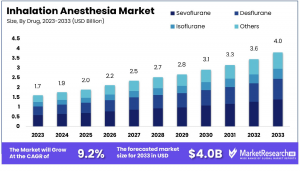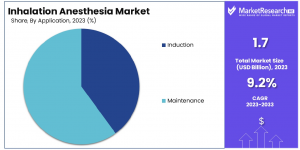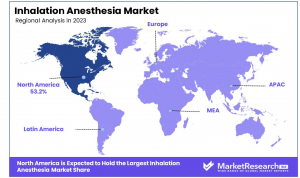Inhalation Anesthesia Market to Expand at 9.2% CAGR, Projected to Hit USD 4.0 Billion by 2033
The Global Inhalation Anesthesia Market was valued at USD 1.7 billion in 2023. It is expected to reach USD 4.0 billion by 2033, with a CAGR of 9.2%
In 2023, Maintenance held a dominant market position in the "By Application" segment of the Inhalation Anesthesia Market, capturing more than an 85% share.”
NEW YORK, NY, UNITED STATES, February 13, 2025 /EINPresswire.com/ -- overview— Tajammul Pangarkar
The Global Inhalation Anesthesia Market was valued at USD 1.7 billion in 2023. It is expected to reach USD 4.0 billion by 2033, with a CAGR of 9.2% during the forecast period from 2024 to 2033.
Inhalation anesthesia plays a vital role in surgical procedures, ensuring patient safety and comfort. This method involves administering anesthetic gases through a mask or endotracheal tube, leading to rapid induction and precise control of anesthesia depth.
Commonly used inhalation anesthetics include sevoflurane, isoflurane, and desflurane, known for their fast onset, quick recovery times, and minimal side effects. These agents help surgeons perform complex procedures with reduced patient discomfort and improved safety.
With the rising number of surgeries worldwide, the global inhalation anesthesia market is expanding, driven by technological advancements and the growing adoption of outpatient surgical procedures. Modern anesthesia delivery systems enhance precision, minimizing risks and improving patient outcomes.
Regulatory bodies such as the FDA and EMA set strict guidelines for inhaled anesthetic agents, ensuring their efficacy and safety. Ongoing research focuses on developing eco-friendly alternatives to reduce the environmental impact of inhalation anesthetics.
As healthcare institutions prioritize efficiency and safety, inhalation anesthesia remains a preferred choice due to its reliability, rapid reversibility, and minimal metabolic impact. Its continued advancements promise a safer and more effective future in anesthetic care.
Click here to get a Sample report copy @ https://marketresearch.biz/report/inhalation-anesthesia-market/request-sample/
Key Takeaways
•Market Size & Growth: The global inhalation anesthesia market was valued at USD 1.7 billion in 2023 and is projected to reach USD 4.0 billion by 2033, growing at a CAGR of 9.2% from 2024 to 2033.
•By Drug: Sevoflurane dominated the market, accounting for 63% of the total drug segment.
•By Application: Maintenance applications remained the most widely used, holding an 85% market share in application scenarios.
•By End-Use: Hospitals emerged as the leading end-users, representing 69% of the total market share.
•Regional Insights: North America led the market, capturing 53.2% of the global inhalation anesthesia industry.
•Growth Opportunities: The market is expanding due to advancements in pediatric anesthesia devices and the increasing adoption of sevoflurane and desflurane, which offer improved efficiency and lower environmental impact.
Segmentation Analysis
••By Drug Analysis: In 2023, Sevoflurane dominated the inhalation anesthesia drug segment, holding a 63% market share due to its rapid onset and minimal side effects, making it the preferred choice in surgical procedures. Isoflurane remained popular for its cost-effectiveness and low blood gas solubility, while Desflurane gained traction for its faster recovery rate but faced limitations due to its higher cost and potential respiratory irritation. Emerging anesthetic agents remain a minor segment, though ongoing R&D may shift market dynamics.
••By Application Analysis: The maintenance application segment held an 85% market share in 2023, driven by its necessity in prolonged surgical procedures. Maintenance inhalation anesthesia ensures stable sedation, controlled depth, and rapid recovery, making it indispensable for complex surgeries. In contrast, induction anesthesia accounted for a smaller share due to its shorter duration, primarily used to initiate unconsciousness before transitioning to maintenance. Advancements in anesthetic drugs continue to enhance patient safety and procedural efficiency in surgical settings.
••By End-Use Analysis: In 2023, hospitals dominated the inhalation anesthesia market, capturing a 69% market share due to their role in complex and long-duration surgeries. Hospitals benefit from specialized anesthesia teams, advanced monitoring systems, and extensive surgical capabilities, making them the primary consumers of inhalation anesthetics. Ambulatory Surgical Centers (ASCs) held a smaller market share, as they focus on less invasive outpatient procedures. Clinics and specialty surgical centers contributed minimally, performing fewer procedures requiring prolonged anesthesia.
Market Segments
By Drug
•Sevoflurane
•Desflurane
•Isoflurane
•Others
By Application
•Induction
•Maintenance
By End-Use
•Hospitals
•Ambulatory Surgical Centers
•Others
To Purchase this Premium Report@ https://marketresearch.biz/purchase-report/?report_id=2367
Market Dynamics
•Driver: The increasing global volume of surgical procedures necessitates effective anesthesia, positioning inhalation anesthetics as essential due to their rapid onset and controllability. Agents like sevoflurane and isoflurane are favored for their efficacy and safety profiles. The World Health Organization includes such anesthetics in its Model List of Essential Medicines, underscoring their critical role in healthcare. Additionally, advancements in anesthesia delivery systems enhance patient outcomes, further driving market growth.
•Trend: There's a notable shift towards minimally invasive and outpatient surgeries, increasing the demand for anesthetics that allow quick patient recovery. Inhalation anesthetics like desflurane are preferred in these settings due to their rapid elimination and minimal residual effects. Furthermore, the development of environmentally friendly anesthetic agents addresses concerns about the ecological impact of traditional inhalation anesthetics, reflecting a trend towards sustainability in healthcare practices.
•Restraint: Environmental concerns regarding the greenhouse gas emissions of certain inhalation anesthetics pose challenges to market expansion. For instance, desflurane has been identified as having a significant environmental impact. Regulatory bodies are increasingly scrutinizing the use of such agents, potentially leading to stricter guidelines and the need for investment in alternative solutions. Additionally, the high costs associated with some inhalation anesthetics may limit their adoption in resource-constrained settings.
•Opportunity: The growing emphasis on pediatric anesthesia presents opportunities for specialized inhalation anesthetic formulations and delivery systems tailored for children. Developing agents with improved safety profiles and minimal side effects can enhance pediatric care. Moreover, the increasing focus on personalized medicine opens avenues for inhalation anesthetics that can be tailored to individual patient needs, optimizing efficacy and safety. Investments in research to develop such targeted anesthetic solutions can drive future market growth.
Market Key Players
•Halocarbon Products Corporation
•Baxter
•AbbVie Inc.
•Lunan Pharmaceutical Group
•Piramal Enterprises Ltd.
•Sandoz International GmbH
•Fresenius Kabi AG
How Artificial Intelligence (AI) is Changing the Inhalation Anesthesia Market?
•Personalized Anesthesia Management: AI algorithms analyze extensive patient data to tailor anesthesia plans to individual needs. By considering factors such as age, weight, and medical history, AI assists in determining optimal anesthetic dosages, thereby improving patient safety and outcomes.
•Predictive Analytics: Through the examination of large datasets, AI predicts potential complications during surgery. Early identification of patients at risk for adverse events allows anesthesiologists to implement preventive measures, thereby enhancing patient safety.
•Automated Anesthesia Delivery: AI-driven systems facilitate the precise administration of inhalation anesthetics. By continuously monitoring patient vitals and adjusting dosages in real-time, these systems maintain optimal anesthesia levels, reducing the likelihood of human error.
•Enhanced Monitoring and Decision Support: AI enhances patient monitoring by analyzing data from various sources to provide comprehensive insights into patient status. Decision support systems alert anesthesiologists to critical changes, enabling prompt interventions.
•Development of Novel Drug Delivery Systems: AI and machine learning contribute to the creation of advanced drug delivery mechanisms for inhalation anesthetics. Innovations such as digital displays and sensors monitor the precise amount of anesthesia administered, ensuring accurate dosing and improving patient outcomes.
Regional Analysis
The global inhalation anesthesia market exhibits diverse regional trends influenced by healthcare infrastructure, regulatory policies, and surgical procedure prevalence.
North America dominates the market, holding a 53.2% share, driven by advanced medical facilities, high healthcare spending, and the presence of leading pharmaceutical companies in the U.S. and Canada. The region's focus on innovative surgical techniques and the widespread adoption of inhalation anesthetics further fuel growth.
Europe follows with a strong market presence, supported by well-developed healthcare systems, stringent regulatory standards, and increasing investments in healthcare technology. Strict patient safety regulations enhance product quality and market reliability.
Asia-Pacific is witnessing rapid growth, propelled by expanding healthcare infrastructure, rising medical tourism, and a growing demand for minimally invasive surgeries that require efficient anesthesia solutions. Increasing awareness and investments in anesthesia delivery systems contribute to the region’s potential.
The Middle East, Africa, and Latin America are experiencing gradual growth, supported by healthcare reforms, economic development, and government initiatives to improve medical accessibility. However, challenges such as limited access to advanced facilities and a lower number of healthcare professionals per capita remain barriers to market expansion.
Emerging Trends in Inhalation Anesthesia
•Personalized Anesthesia: There's a growing focus on tailoring anesthesia to individual patient needs. This approach, known as precision medicine, aims to enhance patient outcomes by considering personal factors during anesthetic administration.
•Environmental Considerations: Concerns about the environmental impact of anesthetic gases, which can contribute to greenhouse gas emissions, are leading to efforts to minimize their use and develop eco-friendly alternatives.
•Advancements in Delivery Systems: Innovations in anesthesia delivery, such as the use of inhaled anesthetics for sedation in intensive care units, are expanding the applications of inhalation anesthesia beyond traditional surgical settings.
Use Cases of Inhalation Anesthesia
•General Surgery: Inhalation anesthetics like sevoflurane and isoflurane are commonly used to induce and maintain anesthesia during surgeries, providing rapid onset and easy adjustability.
•Pediatric Procedures: Due to their non-invasive administration and controllable effects, inhalation anesthetics are often preferred in pediatric surgeries to ensure patient comfort and safety.
•Intensive Care Unit (ICU) Sedation: Inhaled anesthetics are increasingly used for sedation in ICU patients, offering benefits such as rapid onset and easy titration.
•Status Epilepticus Management: In cases of refractory status epilepticus, inhalation anesthetics have been employed to control seizures when traditional medications are ineffective.
Lawrence John
Prudour
+91 91308 55334
Lawrence@prudour.com
Legal Disclaimer:
EIN Presswire provides this news content "as is" without warranty of any kind. We do not accept any responsibility or liability for the accuracy, content, images, videos, licenses, completeness, legality, or reliability of the information contained in this article. If you have any complaints or copyright issues related to this article, kindly contact the author above.



